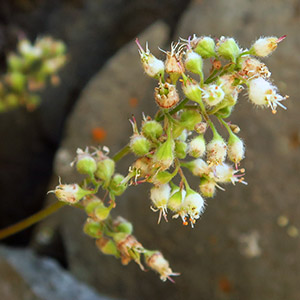Heuchera merriamii
Heuchera hirsutissima
Canyon Creek alumroot, Merriam's alumroot
shaggyhair alum-root
11–32 cm, long stipitate-glandular or glabrate.
10–40 cm, short stipitate-glandular and sparsely long stipitate-glandular.
petiole (2.4–5 cm), moderately long stipitate-glandular;
blade orbiculate, reniform, or pentagonal, shallowly 5–7-lobed, 2.5–4.5 cm, base shallowly cordate to truncate, lobes rounded, margins dentate, apex rounded to obtuse, surfaces finely long stipitate-glandular abaxially, sparsely long stipitate-glandular adaxially.
petiole long stipitate-glandular;
blade orbiculate to reniform, shallowly 5-lobed, 1–1.5 cm, base cordate, lobes rounded, margins dentate, apex obtuse, surfaces long stipitate-glandular.
dense; (bracts linear and scarious to 3–5-parted and herbaceous).
hypanthium radially symmetric, free 0.5–1.5 mm, pink, hemispheric, 3–5.5 mm, (base rounded), densely long stipitate-glandular;
sepals erect, green- or red-tipped, equal, 1–2 mm (often wider than long), apex obtuse;
petals erect, white, oblanceolate, (clawed), unlobed, 2–3.5 mm, margins entire;
stamens exserted 0.8–2 mm;
styles exserted 1–2 mm, 1.5–2.5 mm, 0.1+ mm diam.
hypanthium strongly bilaterally symmetric, free 0.8 mm on abaxial side, 1.8 mm on adaxial side, pink, narrowly cylindric, 5–6.5 mm, short stipitate-glandular proximally, densely long stipitate-glandular distally;
sepals spreading, green- and red-tipped, unequal, 0.5–1.5 mm on abaxial side of hypanthium, to 0.5 mm on adaxial side, apex rounded;
petals spreading, white, oblanceolate, (clawed), unlobed, 2–2.5 mm (equaling or longer than sepals, rarely shorter), margins entire;
stamens exserted to 0.5 mm;
styles included to 0.5 mm, 1.5 mm, 0.1+ mm diam.
ovoid, 3–5 mm, beaks divergent, not papillose.
ovoid, 3 mm, beaks divergent, not papillose.
dark brown, ellipsoid, 0.6 mm.
dark brown, ellipsoid, ca. 0.7 mm.
dense.
= 14.
= 14.
Heuchera merriamii
Heuchera hirsutissima
Heuchera merriamii is known from the Siskiyou and Trinity mountains.
(Discussion copyrighted by Flora of North America; reprinted with permission.)
Of conservation concern.
Heuchera hirsutissima is known from Mount San Jacinto and the San Jacinto Mountains of Riverside County and possibly the San Bernardino Mountains of San Bernardino County. It resembles H. caespitosa and H. elegans, except for its densely villous hypanthium and minute adaxial sepals.
(Discussion copyrighted by Flora of North America; reprinted with permission.)


